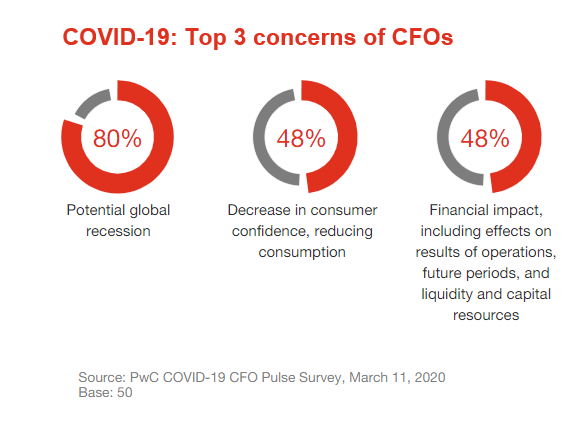
Blog
Combating COVID-19 Uncertainty: 3 Steps for CFOs
The Consumer Brands Association is working with PwC to provide our members with perspectives on how companies and functional leadership can best focus their efforts as the coronavirus evolves.
The economic uncertainty triggered by COVID-19 (coronavirus) is already evident. The longest bull market in US history ended abruptly this month after the sharpest one-day fall since the market crash of October 1987. Both the Dow Jones and the S&P 500 have fallen by more than 20 percent in a single month. Financial markets may continue to react, depending on how companies plan for and respond to the vast uncertainty. For CPG leaders, we recommend structuring responses to manage our work today, as well as in the weeks and months ahead.
In our second piece of this series, we will highlight how financial leaders at CPG companies should plan for and respond to crises.

As the virus spreads, its impact across the CPG value chain is inevitable. Many business leaders already confront the realities of this disruption — from supply shortages to workforce interruptions — with no immediate end in sight.
CPG financial leaders are grappling with answers to complex questions such as:
- To help better position the company’s financial position, what steps should we take to conserve cash while seeking to maximize available credit?
- How do we minimize potential disruption to financial operations, given our people will be geographically dispersed and potentially disrupted? What types of disclosures should we be issuing to stakeholders — nature, amount, effect?
- How do we evaluate strategic opportunities for growth in this environment?
Leaders are well advised to continually update crisis-response planning to:
- Expand access to cash while minimizing outlay
- Manage a geographically dispersed — and anxious — workforce
- Uncover M&A opportunities
1. Expand access to cash while minimizing outlay
COVID-19 implications — both direct and indirect — are already affecting supply chains, service providers, business partners, capital providers and business practices. Companies are already beginning to draw on their cash reserves while looking internally across receivables, payables and inventory for opportunities to improve cash position.
- Understand your current position
- Identify how much cash you have globally and where it is.
- Assess if it is restricted, or readily available for use.
- Identify key cash flows that may be exposed.
- Forecast ongoing needs
- Model your cash needs for the next 3-6 months, based on the business outlook. Identify key triggers that might precipitate specific actions.
- Build “what if” scenarios to better understand each element of financial reporting that may be affected by the outbreak and the corresponding guidance to disclose.
- Free trapped cash
- Improve cash conversion cycles — receivables, payables and inventory.
- Target a subset of customer receivables with payment discounts to help incentivize early payment.
- Tap into back-stop facilities to access additional cash by:
- Drawing on existing revolving credit lines
- Issuing debt/equity
- Holding off on dividend payments
- Discontinuing the share repurchase program
- Speeding up (or delaying) any repatriation plans.
Considering the liquidity in the market, and what other companies may be doing, it’s important to be better aligned with the capital markets and your bankers in this period of stress.
- Consider ways to minimize outlay
- Defer capital expenditures, non-essential projects and non-labor expenses; halt discretionary spending.
- Bifurcate your vendor profile to make more optimal decisions about holding payments — or even accelerating payments to strategic suppliers.
- Consider temporary steps such as workforce furloughs and possibly longer-lasting options such as organizational structure evaluation for management layers and spans of control.
- Re-examine the composition of your workforce — contract, gig, other — as well as flexible working options and compensation structure.
- Identify potential opportunities to reduce SG&A — costs marketing, trade, professional services and more.
- Evaluate underperforming portfolio items and facilities with low productivity, excess capacity or soon-to-expire leases.
- Move quickly with a long-term view
- Recent disruptions have rewarded those who move quickly when faced with tough choices. To improve your cash position, don’t cut evenly across the board. Manage costs strategically to help protect investments and capabilities that differentiate you now as well as during the recovery.
2. Manage a geographically dispersed — and anxious — workforce
Crisis or not, monthly and quarterly financial reporting continues, necessitating crisis-management protocols for ongoing business operations. Not only are team members possibly at risk of getting ill, they might also have family commitments, for example, children home from school or at-risk relatives who need care. Contingency planning becomes essential.
- Protect people and productivity
- The health and safety of your team is paramount. Support remote work with tested cybersafe technology.
- Identify financial reporting job functions that could be affected by quarantine plans, especially in geographic areas hit hardest by the outbreak.
- Assess the number of full-time-employees required to continue essential operations.
- Identify contingency plans for temporary or contractor support for essential tasks such as closing the books and helping to uphold quality, as well as areas requiring specialized expertise across tax, treasury and accounting.
- Developing response plans based on multiple scenarios stress-tested for various levels of risk.
- Maintain continued connectivity
- Amend policies to help manage business continuity given city quarantines and lockdowns.
- Contact service providers key to the financial close, to enable ongoing service for completion of mission-critical tasks by remote workers. Determine where flexibility is possible while balancing access, control and security.
- Test daily remote connectivity. Confirm teams have access to reports and information required to perform financial close activities remotely.
- Revisit security protocols and data-access plans to allow remote work and access to data for employees and the extended team, for example, contractors, outsourced workers and auditors.
- Account for COVID-19 in financial disclosures
- Consider the potential impact of COVID-19 on financial reporting estimates.
- Identify possible implications of current market volatility and other major uncertainties, including assumptions for key estimates, such as doubtful debtors, impairment, tax and more.
- Ramp up scenario planning to a potential daily analysis of evolving business scenarios on EBITDA and FCF (if applicable).
- Consider discussing the possible impact of the crisis outside the financial statements, for example, in:
- The description of the business
- List of potential disruptions
- Management’s discussion and analysis of results, liquidity and capital resources, including consideration of trends and uncertainties.
3. Uncover M&A opportunities
In a downturn, transaction multiples decline along with the economy, resulting in more attractive valuations. As companies shed assets, the pool of acquisition targets will likely grow. Proactive, timely M&A can help accelerate recovery and provide a competitive advantage. Past recessions illustrate that early transactions generate higher returns, with smaller deals, lower valuation multiples and stronger buyers prevailing.
COVID-19 will likely provide the impetus for marginal players — those that haven’t taken action to realign their business, shore up their balance sheet and address other key areas — to become potential sellers. A broad view of the competitive landscape may become even more important in a downturn than during periods of growth.
- Revisit the deal funnel
- Assess the marketplace for specific vulnerabilities. Actively monitor related threats in both core sector and adjacencies.
- Focus on companies that may enhance your core business.
- Don’t overlook corporate-backed venture capital investments. They could perform just as well during a downturn as during an expansion.
- Evaluate existing corporate-development deal funnels for potential opportunities in light of the current economic environment — lower revenue and liquidity issues at prospective targets.
- Speed matters
- A management team with experience in a previous downturn can help lead with authority. Active, timely dialogue with the Board and Investment Committee is essential to respond promptly to M&A opportunities, especially in this environment when target opportunities may morph quickly.
The inherent nature of this fast-paced crisis requires timely decisions based on credible information available at the time. Moving quickly and iterating — with a long-term view in mind — is a strong defense.
Assess the potential impact to your business and gauge your readiness to respond with PwC’s COVID-19 Navigator. For additional information, visit the Consumer Brands coronavirus resource page or PwC’s coronavirus site or contact one of our subject matter experts:
Steven J. Barr, PwC | Consumer Markets Leader
Ron Kinghorn, PwC | Consumer Markets
Kristin Rivera, Global Crisis Leader
Samrat Sharma, PwC | US CPG Leader
For more unique perspectives on this issue, read previous posts from PwC on IT checklists, marketing best practices, essential workers and workforce considerations.
From providing original research, industry guidance and cutting-edge insights, to advocating on Capitol Hill and shaping policy that will have an impact for years to come, we are committed to delivering for our industry during this crisis. Stay informed.
Published on March 20, 2020
Our Updates, Delivered to You
Receive the latest updates from the Consumer Brands Association.




